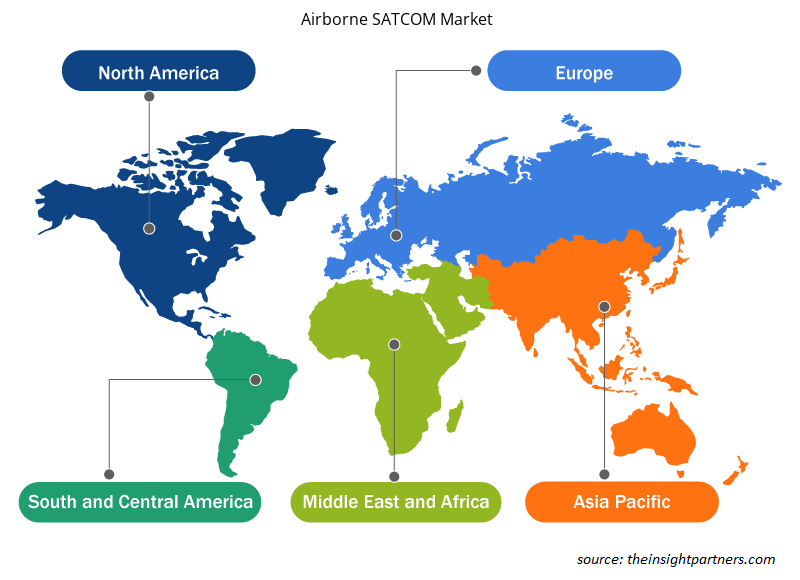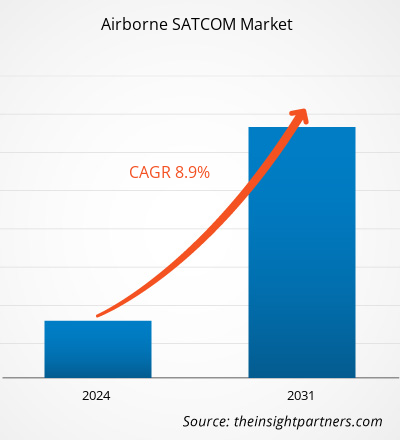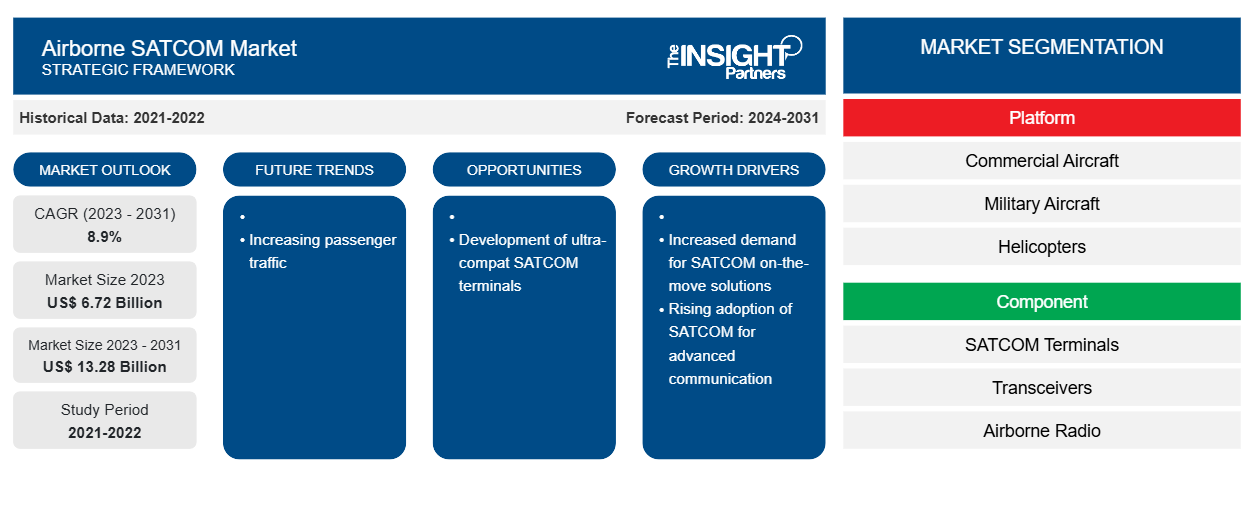Si prevede che la dimensione del mercato SATCOM aereo raggiungerà i 13,28 miliardi di dollari entro il 2031, rispetto ai 6,72 miliardi di dollari del 2023. Si prevede che il mercato registrerà un CAGR dell'8,9% nel periodo 2023-2031. È probabile che l'aumento del traffico passeggeri aereo rimanga una tendenza chiave nel mercato.
Analisi del mercato SATCOM aereo
Gli operatori SATCOM aerei includono Collins Aerospace; Honeywell International Inc.; General Dynamics Mission Systems, Inc.; L3Harris Technologies, Inc.; Viasat, Inc.; Astronics Corporation; e molti altri. Il mercato SATCOM aereo ha un gran numero di piccoli operatori impegnati nel business che detiene una quota significativa del mercato globale. I piccoli operatori sono anche coinvolti in attività di R&S per lo sviluppo di nuove tecnologie che stanno ulteriormente rafforzando le dimensioni del mercato nei prossimi anni. Queste organizzazioni nel corso degli anni hanno aumentato i loro investimenti nello sviluppo di nuovi e avanzati SATCOM aerei in base alle crescenti esigenze dei clienti con l'aiuto degli enti normativi governativi. L'ente normativo governativo aiuta il produttore SATCOM aereo fornendo il contratto alle autorità di difesa, aeroportuali e governative.
Panoramica del mercato SATCOM aereo
I principali stakeholder nell'ecosistema del mercato globale SATCOM aereo includono fornitori di materie prime/componenti, produttori di SATCOM aereo, enti normativi governativi e utenti finali. I fornitori di materie prime/componenti sono gli stakeholder cruciali nell'ecosistema del mercato SATCOM aereo. La principale materia prima utilizzata in SATCOM include un trasmettitore, un ricevitore, un ricetrasmettitore, un'antenna, una radio aerea, modem e router, amplificatori ad alta potenza , batterie e altre apparecchiature. La fornitura tempestiva di tutti questi componenti è fondamentale per un funzionamento efficiente negli impianti di produzione SATCOM aereo. Pertanto, qualsiasi impatto operativo su questi fornitori di componenti ha un impatto diretto sul mercato SATCOM aereo.
Personalizza questo report in base alle tue esigenze
Riceverai la personalizzazione gratuita di qualsiasi report, comprese parti di questo report, o analisi a livello nazionale, pacchetto dati Excel, oltre a usufruire di grandi offerte e sconti per start-up e università
-
Scopri le principali tendenze di mercato in questo rapporto.Questo campione GRATUITO includerà analisi di dati che spaziano dalle tendenze di mercato alle stime e alle previsioni.
Driver e opportunità del mercato SATCOM aereo
Aumento della domanda di soluzioni SATCOM On-The-Move (OTM)
Una delle applicazioni più importanti della tecnologia di comunicazione satellitare è la comunicazione in movimento (COTM), che fornisce servizi essenziali a varie aziende. La COTM fornisce importanti applicazioni per i primi soccorritori, il ripristino in caso di calamità, la preparazione alle emergenze, l'accesso remoto e altre applicazioni per utenti finali militari e commerciali. Inoltre, gli aeromobili in movimento come i veicoli aerei commerciali, governativi e senza pilota (UAV) dotati di una parabola satellitare in grado di stabilire e sostenere comunicazioni con una rete satellitare mentre l'aeromobile è in movimento sono indicati come COTM. La domanda di comunicazioni in movimento basate su satellite (COTM) è emersa come una nuova tendenza nei sistemi di comunicazione aerea commerciale e di difesa. Le tecnologie COTM sono diventate significativamente più efficaci grazie all'arrivo di satelliti L-band ad alta potenza con soluzioni di antenna a basso guadagno progettate originariamente per i settori della sicurezza e della difesa. A novembre 2018, Get SAT ha annunciato il rilascio dell'antenna UltraBlade L-Band per applicazioni aeree L-band in movimento. Clienti e operatori, sia commerciali che militari, desiderano velocità più elevate e prezzi della larghezza di banda più competitivi. Le reti degli operatori vengono limitate poiché le diverse piattaforme richiedono nuovi tipi di antenne o modalità di acquisto della connettività, portando allo sviluppo di soluzioni SATCOM avanzate in movimento.
Sviluppo di terminali SATCOM ultracompatti
I droni con capacità tattiche a lungo raggio vengono utilizzati per acquisire e trasmettere dati di intelligence, sorveglianza e ricognizione (ISR) in tempo reale alle stazioni di terra. Le comunicazioni satellitari affidabili e ad alte prestazioni garantiscono una connettività a banda larga continua nelle attività oltre la linea di vista (BLOS). Negli ultimi anni, si è registrato un aumento significativo della domanda di piccoli veicoli aerei (UAV) con terminali SATCOM L-Band ad alte prestazioni e capacità di trasmissione con un ingombro ridotto. Ad esempio, Intellian ha annunciato nell'ottobre 2021 che i suoi nuovi terminali L-band FB250 e Fleet One hanno ricevuto la certificazione di tipo Inmarsat. Il terminale Intellian Fleet One è una soluzione piccola, robusta e a basso costo per comunicazioni telefoniche e dati simultanee fino a 150 kbps. Inoltre, a gennaio 2022, Inmarsat, leader di mercato nelle comunicazioni satellitari mobili internazionali, ha consentito all'ultra-intelligence e alle comunicazioni di utilizzare il suo nuovo terminale SATCOM ultracompatto con la rete Inmarsat Global Xpress. Il nuovo ultra-terminale è all'avanguardia in termini di dimensioni, peso, potenza e standard prestazionali più elevati per creare una capacità di comunicazione nel campo delle operazioni, facilitando le comunicazioni critiche per la missione tra i soldati sul campo e il comando e controllo.
Analisi della segmentazione del rapporto di mercato SATCOM aereo
I segmenti chiave che hanno contribuito alla derivazione dell'analisi del mercato SATCOM aereo sono piattaforma, componente e applicazione.
- In base alla piattaforma, il mercato SATCOM aereo è segmentato in aerei commerciali, aerei militari, elicotteri e UAV. Il segmento degli aerei commerciali ha detenuto una quota di mercato maggiore nel 2023.
- In base al componente, il mercato SATCOM aereo è segmentato in terminali SATCOM, transceiver, radio aeree, modem e router, radome SATCOM e altri. Il segmento dei transceiver ha detenuto una quota di mercato maggiore nel 2023.
- In base all'applicazione, il mercato SATCOM aereo è segmentato in difesa e commerciale. Il segmento commerciale ha detenuto una quota di mercato maggiore nel 2023.
Analisi della quota di mercato delle comunicazioni satellitari aeree per area geografica
L'ambito geografico del rapporto sul mercato SATCOM aereo è suddiviso principalmente in cinque regioni: Nord America, Europa, Asia Pacifico, Medio Oriente e Africa e Sud America.
L'Asia Pacifica ha dominato il mercato nel 2023, seguita dalle regioni del Nord America e dell'Europa. Inoltre, è probabile che anche l'Asia Pacifica assista al CAGR più elevato nei prossimi anni. La Cina è uno dei paesi più grandi nella regione Asia Pacifica che ha la popolazione più numerosa a livello mondiale ed è uno dei più grandi centri di produzione al mondo. La Cina ha stabilimenti di Boeing, Airbus, COMAC, Pratt & Whitney, Changhe Aircraft Industries Corporation, Chongqing Helicopter Investment Corporation, Harbin Aircraft Industry Group, Yuneec International, Shenyang Aircraft Corporation, AVIC Aircraft Corporation e Guizhou Aircraft Industry Corporation. Il paese ha assistito a una crescita sostanziale nella produzione e nella fabbricazione di aeromobili, UAV, elicotteri e altre parti di aeromobili insieme a un polo di produzione aerospaziale ben consolidato. Ad esempio, entro la fine del 2021 COMAC ha annunciato di aver consegnato circa 66 aeromobili di fabbricazione cinese in tutto il paese; anche Airbus China ha annunciato di aver consegnato circa 142 aeromobili commerciali in tutto il paese nello stesso periodo.
Approfondimenti regionali sul mercato SATCOM aereo
Le tendenze regionali e i fattori che influenzano il mercato Airborne SATCOM durante il periodo di previsione sono stati ampiamente spiegati dagli analisti di Insight Partners. Questa sezione discute anche i segmenti e la geografia del mercato Airborne SATCOM in Nord America, Europa, Asia Pacifico, Medio Oriente e Africa e America meridionale e centrale.

- Ottieni i dati specifici regionali per il mercato SATCOM aereo
Ambito del rapporto sul mercato SATCOM aereo
| Attributo del report | Dettagli |
|---|---|
| Dimensioni del mercato nel 2023 | 6,72 miliardi di dollari USA |
| Dimensioni del mercato entro il 2031 | 13,28 miliardi di dollari USA |
| CAGR globale (2023-2031) | 8,9% |
| Dati storici | 2021-2022 |
| Periodo di previsione | 2024-2031 |
| Segmenti coperti |
Per piattaforma
|
| Regioni e Paesi coperti |
America del Nord
|
| Leader di mercato e profili aziendali chiave |
|
Densità degli attori del mercato: comprendere il suo impatto sulle dinamiche aziendali
Il mercato Airborne SATCOM Market sta crescendo rapidamente, spinto dalla crescente domanda degli utenti finali dovuta a fattori quali l'evoluzione delle preferenze dei consumatori, i progressi tecnologici e una maggiore consapevolezza dei vantaggi del prodotto. Con l'aumento della domanda, le aziende stanno ampliando le loro offerte, innovando per soddisfare le esigenze dei consumatori e capitalizzando sulle tendenze emergenti, il che alimenta ulteriormente la crescita del mercato.
La densità degli operatori di mercato si riferisce alla distribuzione di aziende o società che operano in un particolare mercato o settore. Indica quanti concorrenti (operatori di mercato) sono presenti in un dato spazio di mercato in relazione alle sue dimensioni o al valore di mercato totale.
Le principali aziende che operano nel mercato Airborne SATCOM sono:
- ASELSAN A.
- Gruppo Talete
- Azienda aerospaziale Collins
- Cobham limitata
- Honeywell International Inc.
Disclaimer : le aziende elencate sopra non sono classificate secondo un ordine particolare.

- Ottieni una panoramica dei principali attori del mercato Airborne SATCOM
Notizie e sviluppi recenti sul mercato SATCOM aereo
Il mercato SATCOM aereo viene valutato raccogliendo dati qualitativi e quantitativi dopo la ricerca primaria e secondaria, che include importanti pubblicazioni aziendali, dati associativi e database. Di seguito sono elencati alcuni degli sviluppi nel mercato SATCOM aereo:
- Astronics Corporation (Nasdaq: ATRO), fornitore leader di tecnologie avanzate per i settori aerospaziale, della difesa e di altre industrie mission critical a livello globale, ha lanciato oggi il sistema Typhon T-400 Series, che rappresenta la prossima generazione di tecnologia di connettività per comunicazioni satellitari (SATCOM). Il Typhon T-400 Series è progettato per funzionare senza problemi su qualsiasi rete satellitare Ku basata su GEO, affrontando efficacemente le sfide associate all'elevato costo di dotare un aeromobile di connettività SATCOM. (Fonte: Astronics Corporation, comunicato stampa, marzo 2024)
- Viasat Inc. (NASDAQ: VSAT), una società di comunicazioni globale, ha annunciato oggi di aver integrato una tecnologia aerea a banda larga Ku e Ka sicura e flessibile sull'aereo Airbus C295 MSA per l'Irish Air Corps (IAC), una divisione delle Forze di difesa irlandesi focalizzata sulla difesa aerea militare dello spazio aereo irlandese e a supporto delle operazioni di mantenimento della pace delle Nazioni Unite. Viasat e Airbus hanno collaborato per integrare il terminale a banda larga dual-band flessibile di Viasat, il GAT-5530, sull'aereo C295 MSA per fornire capacità migliorate a questa piattaforma aerea militare multiuso. Airbus ha completato la consegna di due aerei C295 MSA alle Forze di difesa irlandesi all'inizio di quest'anno. (Fonte: Viasat Inc., comunicato stampa, dicembre 2023)
Copertura e risultati del rapporto sul mercato SATCOM aereo
Il rapporto "Airborne SATCOM Market Size and Forecast (2021–2031)" fornisce un'analisi dettagliata del mercato che copre le seguenti aree:
- Dimensioni e previsioni del mercato SATCOM aereo a livello globale, regionale e nazionale per tutti i segmenti di mercato chiave coperti dall'ambito
- Tendenze del mercato SATCOM aereo e dinamiche di mercato come driver, restrizioni e opportunità chiave
- Analisi dettagliata delle cinque forze di Porter
- Analisi del mercato SATCOM aereo che copre le principali tendenze del mercato, il quadro globale e regionale, i principali attori, le normative e i recenti sviluppi del mercato
- Analisi del panorama industriale e della concorrenza che copre la concentrazione del mercato, l'analisi della mappa di calore, i principali attori e gli sviluppi recenti per il mercato SATCOM aereo
- Profili aziendali dettagliati
- Analisi storica (2 anni), anno base, previsione (7 anni) con CAGR
- Analisi PEST e SWOT
- Valore/volume delle dimensioni del mercato - Globale, Regionale, Nazionale
- Industria e panorama competitivo
- Set di dati Excel
Report recenti
Testimonianze
Motivo dell'acquisto
- Processo decisionale informato
- Comprensione delle dinamiche di mercato
- Analisi competitiva
- Analisi dei clienti
- Previsioni di mercato
- Mitigazione del rischio
- Pianificazione strategica
- Giustificazione degli investimenti
- Identificazione dei mercati emergenti
- Miglioramento delle strategie di marketing
- Aumento dell'efficienza operativa
- Allineamento alle tendenze normative























 Ottieni un campione gratuito per - Mercato SATCOM aereo
Ottieni un campione gratuito per - Mercato SATCOM aereo